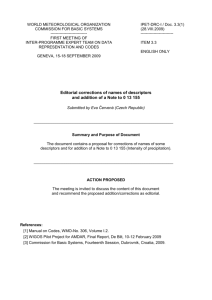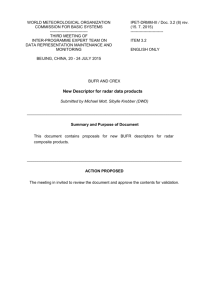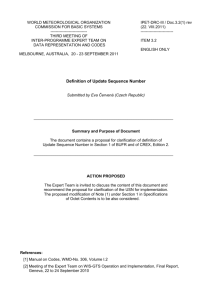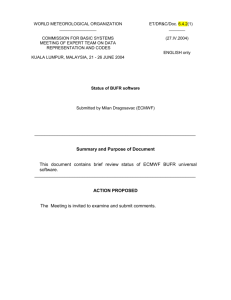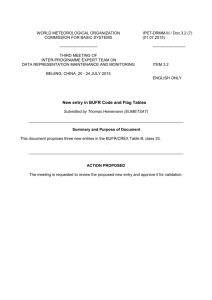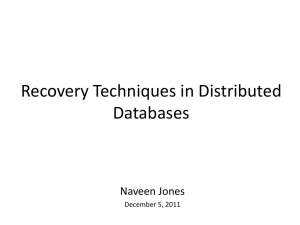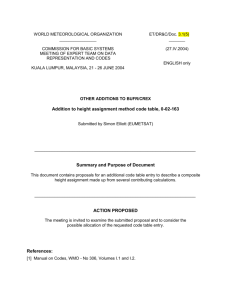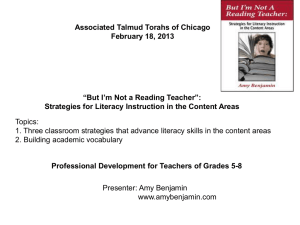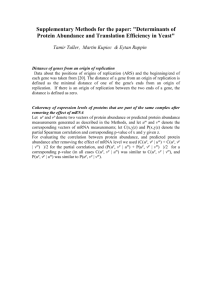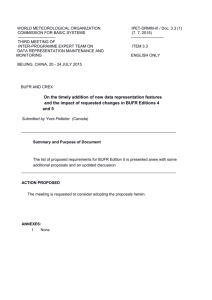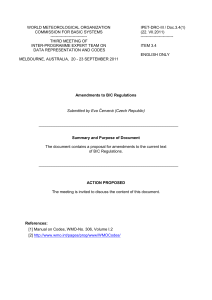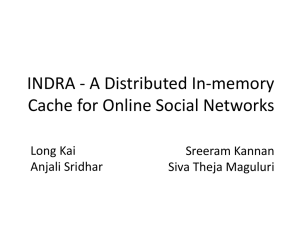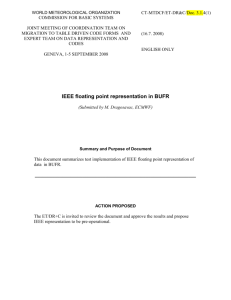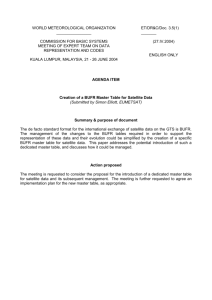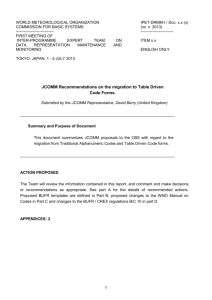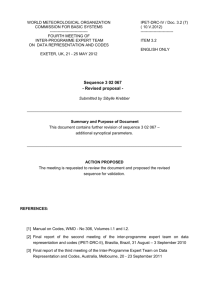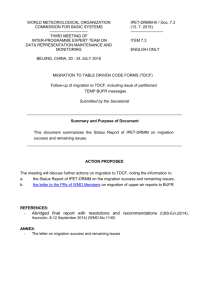world meteorological organization
advertisement
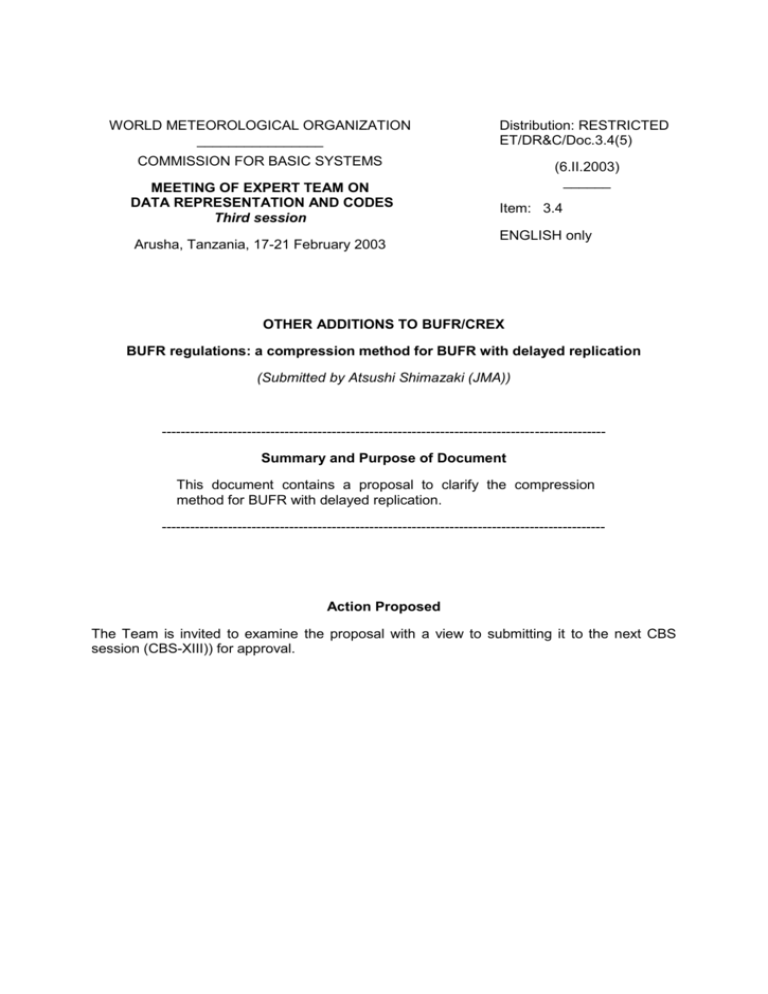
WORLD METEOROLOGICAL ORGANIZATION ________________ Distribution: RESTRICTED ET/DR&C/Doc.3.4(5) COMMISSION FOR BASIC SYSTEMS (6.II.2003) ______ MEETING OF EXPERT TEAM ON DATA REPRESENTATION AND CODES Third session Arusha, Tanzania, 17-21 February 2003 Item: 3.4 ENGLISH only OTHER ADDITIONS TO BUFR/CREX BUFR regulations: a compression method for BUFR with delayed replication (Submitted by Atsushi Shimazaki (JMA)) ---------------------------------------------------------------------------------------------Summary and Purpose of Document This document contains a proposal to clarify the compression method for BUFR with delayed replication. ---------------------------------------------------------------------------------------------- Action Proposed The Team is invited to examine the proposal with a view to submitting it to the next CBS session (CBS-XIII)) for approval. ET/DR&C /Dec.3.4(5) /p.2 DISCUSSION 1. The last meeting of ET/DR&C noticed a problem on data compression of BUFR message with delayed replication, and last summer, this matter was discussed among the member of ET/DR&C, especially members from USA, JCOMM, EUMETSAT, UK and Japan by e-mail. 2. If the number of replications in each data subset, which corresponds with a certain replication operation equals each other, obviously the binary data can be described as follows regardless of simple or delayed replication. In non-compressed form R11 R21 . Rn1 R12 R22 . Rn2 R13 R23 . Rn3 R14 R24 . Rn4 R15 R25 . Rn5 ...... ...... ...... ...... In compressed form R1s R2s . Rns Ro1 Ro2 Ro3 . Ros NBINC1 NBINC2 NBINC3 . NBINCs I11 I21 I31 . Is1 I12 I22 I32 . Is2 ...... ...... ...... ...... ...... I1n I2n I3n . Isn where Rij (i=1 to n, j=1 to s) is jth value of ith data subset, Roj (j=1 to s) is local reference value for jth value of each data subset, NBINCj (j=1 to s) is the number of bits occupied by the increment Iji, Iji (j=1 to s, i=1 to n) is an increment for jth value of ith data subset. s is the number of values per data subset and n is the number of data subsets in the BUFR message. 3. However, if a delayed replication is employed in a BUFR message and the numbers of replications are not equal, the binary data in non-compressed form may be described as follows assuming the values Rij (i=1 to n, j=2 to 4) correspond with the delayed replication, and the numbers of replications are two for the first subset, one for the second subset, ......, and three for nth subset. R11 R12 R13 R14 ...... R1(s-1) R21 R22 R23 ...... R2(s-2) . . . . . ...... . Rn1 Rn2 Rn3 Rn4 Rn5 ...... Rns where s is the maximum number of replications for the delayed replication. 4. In the strict sense, the values R14, R23 and R24 in Item 3 above are nothing (blank) rather missing according to the definition of BUFR regulations. If missing, the compressed Iji shall be coded as 1....1 (a value all bits set) according to the regulation 94.1.6, but the compression method for the case of nothing is not clearly described in the Manual on Codes. Therefore the lines of Ro3 and Ro4 in compressed form is not defined in this case. 5. In the course of migration to the table driven codes, centres would be oliged to combine individual observations into one BUFR message (bulletin) to exchange it through the GTS. Moreover, there are some types of observations which inevitably require delayed replications, such as PILOT/TEMP and profiling floats observations and so on. Therefore it is necessary to define when compression is possible with delayed replication explicitly. PROPOSAL Add a subnote to the NOTE (2) of regulation 94.6.3 as follows. (ix) When delayed replication is present, it is required that the number of replications shall be identical for each data subset if data compression is to be used. In such cases, subnote (vii) shall apply when coding the number of replications.
